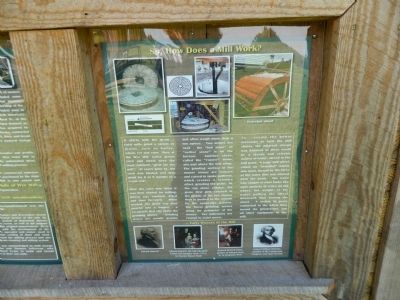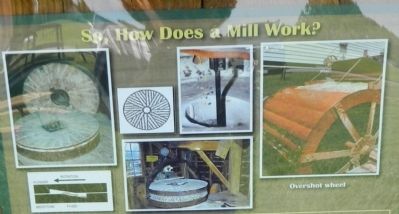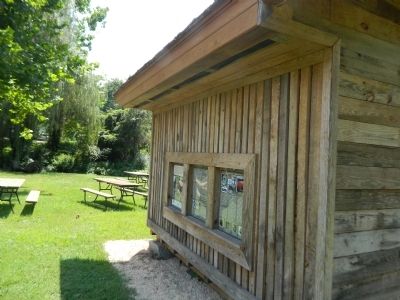Wye Mills in Talbot County, Maryland — The American Northeast (Mid-Atlantic)
So, How Does a Mill Work?
After the corn was dried it was then shelled for milling. Wheat was similarly dried and then threshed. When needed, the grain was then poured into a hopper - a receptacle that sits above the grinding stones. Grinding stones are usually granite, and often weigh more than a ton apiece. Two stones are used - the "bed stone" or "nether stone" is on the bottom. Another stone, called the "runner" stone, sits just above the bed stone. The grinding surface of the runner stones are concave and carved in spoke patterns, which creates a scissors effect, grinding the grain. As the top stone rotates, the grain first gets cracked in the middle of the two stones; then is pushed to the outside by the spoke-like pattern. The finest grinding occurs along the perimeter of the stones. The millstones are rotated by water power.
To create the power necessary to turn the mill stones, the adjacent stream was dammed so there would be a steady and reliable source of water, stored in the mill pond. A large mill wheel, called an "overshot" wheel was used, turned by the force of the water that was sluiced from the pond. The water was caught in what looks like open pockets or trays on the wheel, the weight of the water pulling the wheel downward, thus turning the wheel. A system of gears connected to the wheel then turned the grindstones and all other equipment in the mill.
Erected by Friends of Wye Mill.
Topics. This historical marker is listed in these topic lists: Agriculture • Industry & Commerce • Science & Medicine.
Location. 38° 56.5′ N, 76° 4.875′ W. Marker is in Wye Mills, Maryland, in Talbot County. Marker is on Wye Mills Road (County Route 662). Touch for map. Marker is in this post office area: Wye Mills MD 21679, United States of America. Touch for directions.
Other nearby markers. At least 8 other markers are within walking distance of this marker. A Brief History of the Mill (here, next to this marker); Wye Grist Mill (here, next to this marker); a different marker also named The Wye Grist Mill (a few steps from this marker); Wye Grist Mill and Museum (within shouting distance of this marker); The “Little House” in the Shade (approx. 0.2 miles away); Wye Oak House (approx. 0.2 miles away); Wye Oak (approx. 0.2 miles away); Preserving a Legacy (approx. 0.2 miles away). Touch for a list and map of all markers in Wye Mills.
Credits. This page was last revised on June 16, 2016. It was originally submitted on August 4, 2013, by Nathan Davidson of Salisbury, Maryland. This page has been viewed 408 times since then and 12 times this year. Photos: 1, 2, 3, 4. submitted on August 4, 2013, by Nathan Davidson of Salisbury, Maryland. • Bill Pfingsten was the editor who published this page.



